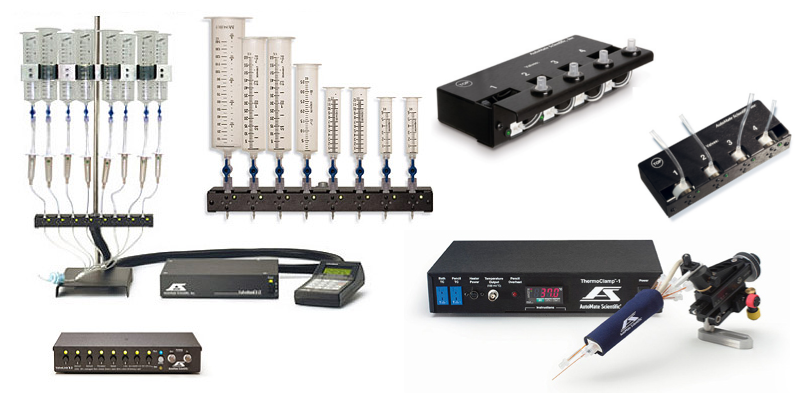
Increase Reproducibility with fewer Hours in the Lab
Avoid vibrations from switching liquids by hand. Use a ValveBank® or ValveLink8.2® controller for solution delivery so that you can watch results - not switch stopcocks. Many special features are included for easy perfusion control and low noise circuitry. All components are included for a complete, ready-to-use perfusion system. Consistent liquid delivery means better data.
Features:
- Unattended solution switching
- Increased reproducibility
- Pinch & PTFE inert and Lee™ Valves
- Manual and external valve control
Perfusion Systems Include:
Controller, valves, 60 ml syringe reservoirs, 2-way stopcocks, ringstand, 1/16" i.d. tubing and four-, eight- or
sixteen-into-one micro-manifold with built-in flow control. Non-pressurized PTFE inert systems include drippers and a
reservoir bracket. 5, 15, 35, 60 or 140 ml syringe reservoirs available.
The Economy Pinch Valve System includes ValveLink8 controller, four pinch valves, 35 ml syringes, 2-way stopcocks,
ringstand, 1/16” i.d. tubing and four-into-one micro-manifold with built-in flow control.
Computer Interfacing:
Perfusion systems can be controlled by a computer using data acquisition hardware (i.e., DigiData, ITC-16, or National
Instruments board) and software (i.e., pCLAMP, Pulse, or LabView). Both ValveBanks and ValveLinks accept real-time TTL
inputs to control valves. Most acquisition software already being used in your experiments can talk to our controllers.
AutoMate Scientific offers an optional program called EasyCode® for the Macintosh and PC/ Windows to program ValveBanks
(not ValveLinks). This software is used before an experiment – valve sequences are downloaded into the memory of the
ValveBank where they are run.
The piezo solution switcher uses a high-speed piezo flexure guided nanopositioner to move pipette tips in solution switching applications. It can move an electrode tip across a 5 µm thick theta glass septum. This system is ideal for measuring cellular response to drugs or other elements in solution. Piezo movement can be triggered by either input from common recording amplifier equipment or by Siskiyou software via a LabVIEW™ interface that can control distance, frequency and dwell time. The piezo also includes the piezo amplifier box and the Input-Shaping® board, which significantly reduces pipette tip vibration and can be programmed to virtually eliminate resonances from your specific system. The piezo flexure guided nanopositioner is mounted to our ultra-stable MX1640 crossed roller micromanipulator. The MX1640 has 20mm of travel in all four axes. The fourth axis can be set at any angle to select the desired approach angle. This adjustable fourth axis incorporates our MXC-45 to allow rotation of the piezo/pipette assembly up and out of the experiment for easy glass replacement. The base of the MX1640 also has a built-in coarse adjustment for rotation of the entire manipulator, or can also be used with our MX-RS rotation stage for more precise motion. |
|

